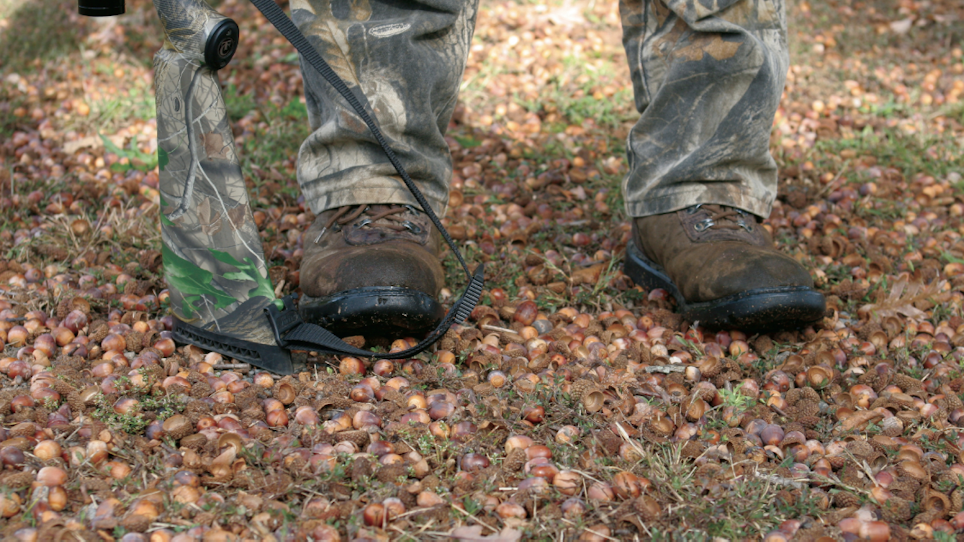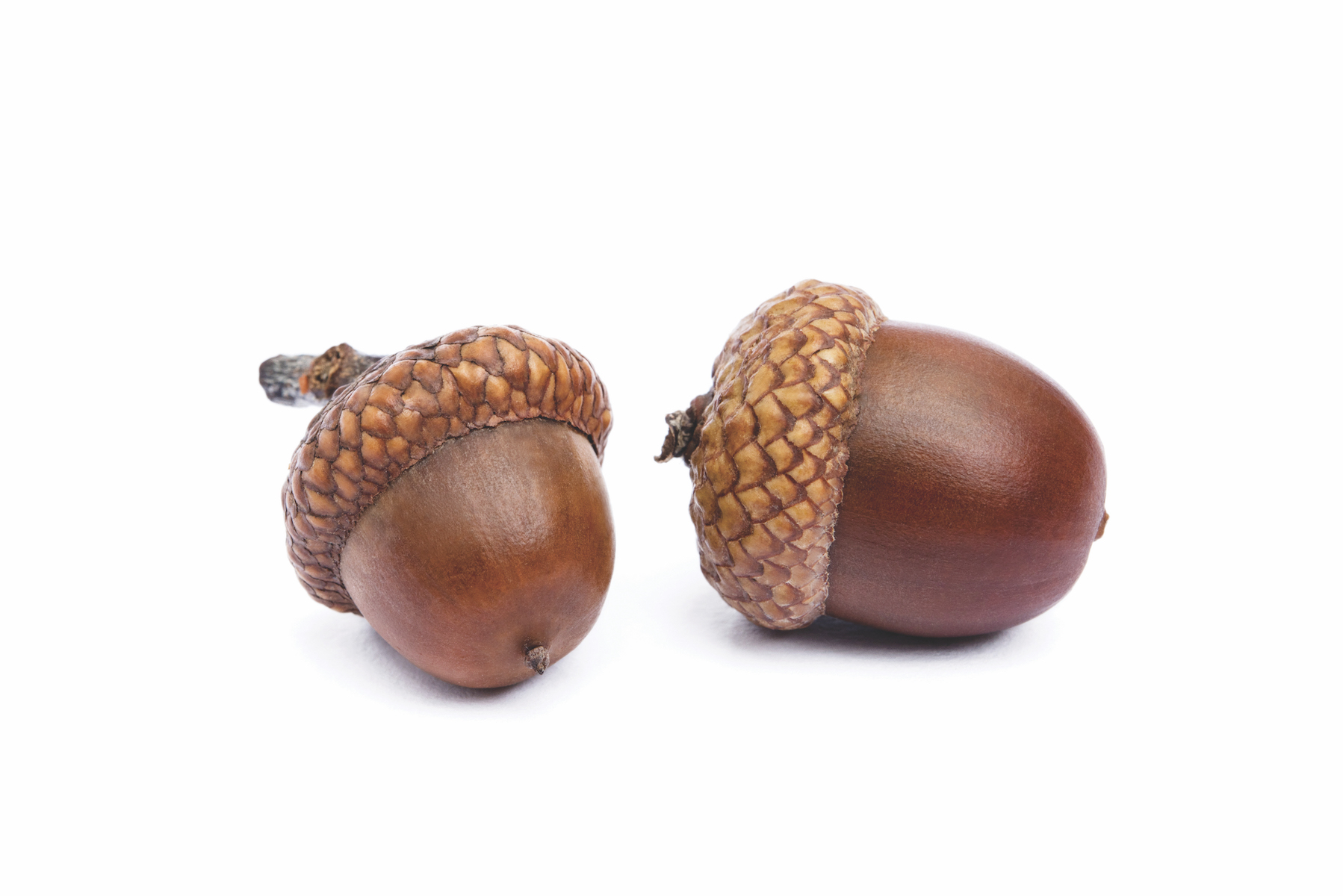Can we have too much of a good thing? When it comes to deer hunting, the answer is usually a resounding “no.” Unless that “thing” happens to be acorns. Some years, it’s all but impossible to walk under an oak tree without crunching a dozen or more nuts with each step. It seems like all a deer has to do is tip its head back, open his mouth and let the acorns fall right down its throat.
That may be a bit of an exaggeration, but it isn’t too far from the mark. When deer have an abundance of high-quality food, they don’t move much because they don’t have to. Don’t believe it? Track annual deer kills in your state and compare them to the mast crop. The more acorns that drop, the fewer deer that hit the ground.
So how do you hunt deer when they don’t need to travel more than a few feet to fill their bellies? There’s no question killing any deer, let alone a trophy-class buck, becomes much harder when the acorns are falling from the trees like rain during a summer thunderstorm.
“It’s tough. There’s no two ways around it,” says Virginia hunter Gary Ranson. “I definitely don’t see as many deer as I do when there are few or no acorns. Sometimes, I don’t see any deer in a morning or afternoon hunt. They just don’t move as much, but they haven’t gone anywhere. They are still out there and they have to eat.”
Beat the Rush
How you hunt depends on a few things. First, does your season begin before, during or after the start of the acorn drop? If you can get on the first acorns of the year in late September or early October, you automatically give yourself an edge, says West Kentucky Whitetails outfitter, Tad Ladd.
“Deer will find those first acorns to hit the ground and they will keep coming back to that spot, even when other trees start dropping. However, once they eat all those acorns or the woods are full of acorns, all bets are off,” says Ladd.
Ignore Them
When that happens, Ladd will sometimes keep doing what he always does, which is hunt over other food sources like corn, beans and food plots. Although deer focus on acorns, they continue to eat other foods; although, nowhere near the same frequency. A study of deer stomach contents in southwest Virginia during years of high acorn abundance found the animals did rely heavily on the nuts. Acorns made up three-quarters of a deer’s diet when those nuts were available. However, that means one-quarter of their diet was something else.
“I have two places where white oaks border my food plots. When those trees are producing acorns, I have the best of both worlds,” says Ranson. “I just hunt my food plots like I always do because even when the deer are working on those acorns, they will still step out into the food plots to feed on the green stuff. I think they like a variety of foods just like we do.”
Ladd agrees. His clients see fewer deer overall when acorns are blanketing the ground, but they still see deer including plenty in other food sources like plots of clover and cereal grains. To up the odds, he will spread corn in his food plots (legal in Kentucky) to make a spot even more attractive. It often works.
That’s due in part to deer behavior. The animals may seem to live in a peaceful coexistence with each other, but in reality, whitetails are just as territorial and defensive as many other wild animals. Bucks will keep other bucks away from does and does will fend off their fellow females from high-quality food sources.
“Some does will end up in your food plots or in an ag field because they have little choice. Dominant does will run off younger ones from the best food. That’s good, though, especially in the rut when bucks are searching. If there are does in our food plots, bucks might come looking for them,” says Ladd. “It’s not out of the question to see that in late September or early October. There is always some early breeding taking place, even if it isn’t much.”
If you Can’t Beat Them, Hunt Them
Sitting over a food plot may be a worthwhile tactic if you have food plots. Not everyone does. However, oaks are generously scattered throughout whitetail country. Nearly everyone has the opportunity to hunt the acorn crop.
“Don’t let an overabundance of acorns keep you out of the woods. The deer are out there, you just have to find them,” says Ranson. “You have to be patient and persistent, too. I don’t always see deer when I hunt, but I will eventually, if I put in my time.”
First, find oaks that are actually drawing deer. For reasons unknown to us, some white oak trees or clusters of oaks produce acorns that are more attractive to whitetails. It probably has something to do with the soil fertility or soil type. Acorns from those trees might have a lower acidity, a higher protein content or some intangible ingredient that only deer can detect. Whatever the reason, some oaks just draw more deer. Keep scouting until you find them.
“Look for a concentration of obvious sign like droppings and tracks. If you look closer, you will see things like lots of acorn caps. Deer don’t eat the caps, so if you see lots of them in addition to obvious sign, you’ve found a good place to hunt,” says Ladd. “You’ll also notice that the leaves have been disturbed, too. Deer don’t scratch up the ground like turkeys do, but they will turn over leaves to get at an acorn. The ground will be all tore up under a hot tree.”
Ranson looks for heavier deer sign under oaks too. He agrees that some trees draw more deer than others do, even when they all seem to be loaded with acorns, so he puts lots of miles on his boots before settling on a few places to hunt.
He does more than pinpoint some hot oaks, though. Once he finds a concentration of acorns and deer sign, Ranson then seeks trails leading to and from known bedding areas. He hunts in southeastern Virginia, where pine plantations are common. Young planted pines are ideal bedding areas. Not only do the pines grow thick, but a wide variety of other plants spring up between the evergreens, creating a jungle of bedding cover.
“I look for trails leading from those bedding areas and hang a stand over it between the bedding and feeding area. When I hunt, it depends on the distance from the food source. I’ll hunt closer to the oaks in the afternoons and closer to the bedding areas in the mornings, so I don’t bump deer as I’m walking in or out,” says Ranson.
Sign Everywhere?
Pinpointing deer sign under high-quality trees can be a slam-dunk, but that’s not always an option. Sometimes it seems like every oak has a smorgasbord of sweet, nutritious nuts and an abundance of deer sign under it. That’s when it is time to focus on bedding areas entirely. Instead of hunting the food source, it can be more productive to hunt near where the deer spend the day.
“We certainly can’t put a stand on every tree dropping acorns, so we focus on transition areas between bedding and feeding areas. Acorns can be anywhere and everywhere, but well-used bedding areas aren’t quite as numerous on the land we hunt,” says Ladd. “We have a pretty good idea of where they bed.”
It helps that he runs dozens of trail cameras throughout the year on the farms he hunts. He not only has tabs on the bucks on his properties, but the trails and general locations they frequent most.
Of course, they can head in any direction once they leave their beds, agree Ladd and Ranson, but that’s just part of the hunting equation, whether the forest is littered with acorns or not.
“Deer are certainly less predictable with so much food available, so there are challenges we wouldn’t normally have, but it wouldn’t be so much fun if it wasn’t so challenging, would it?” asks Ladd.
Hundred-Year-Old Food Plots
Depending on where you hunt, oaks may not be liberally scattered throughout your forest. Instead, they may be clustered in loose groups. In other words, a dozen white oaks dropping acorns create the equivalent of a plot of clover separated by a forest of other tree species. Hunt those groups of oaks much the same way you might hunt your food plots. Ladd and Ranson agree that some oaks draw deer better than others do, so it is critical to find hot stands of trees or even individual trees within clusters of oaks.
How you hunt those patches of oaks depends on the same factors that play into the hunting equation anywhere else. Where will the deer come from? Which way is the wind blowing?
Be Patient
In other words, hunting deer during a bumper crop of acorns isn’t a whole lot different than chasing whitetails when native food sources are scarce. It is certainly more challenging, though.
The good news is that virtually everything in the woods eats acorns. Squirrels bury them by the bushel, turkeys devour them and scores of other bids and mammals love acorns. It may take weeks for the nuts to thin out, but they will eventually. Some that remain will start to decay, making them less attractive to deer. That’s when the hunting gets really good again. Stay at it. You’d be nuts to do anything else.
BONUS: Know Your Nuts
White oak acorns are preferred by whitetails over red oak species. The two varieties of oaks often grow in the same forest, even side-by-side, so it is critical to know the difference. The bad news is that there are several varieties of each and deer aren’t particularly fond of some varieties, even some white oak species.
What’s more, preferences can be localized, based in part on the availability of other species, the soil and the timing of the acorn drop. The best way to understand what the deer favor in your area is to spend lots of time in the woods. Find oaks that are producing a mast crop and look for a variety of sign under them.
First, though, learn to identify the various oak species. A number of apps are available for smart phones and numerous field guides can help you learn what trees you are looking at. Use them. Knowledge can help you have more success.
Featured photo: David Hart







